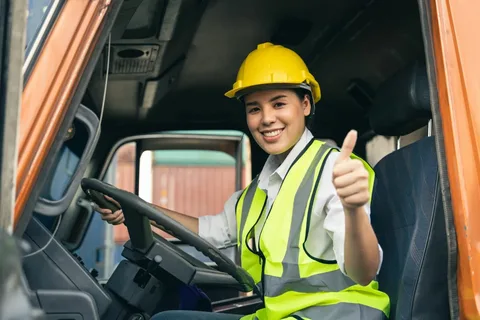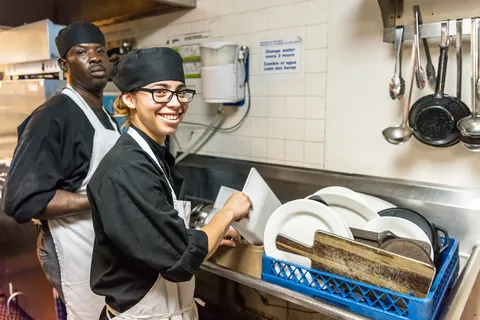The construction industry is a cornerstone of the United States economy, offering numerous opportunities for immigrants seeking employment with visa sponsorship. This comprehensive guide explores the landscape of construction laborer jobs in the USA, detailing the industry’s structure, companies that sponsor visas, required skills and experience, salary expectations across various regions, and steps to enhance employability.
Overview of the U.S. Construction Industry
As of 2025, the construction industry significantly contributes to the U.S. economy, employing millions and generating substantial revenue. The sector is broadly categorized into three main segments:
- Residential Construction: Involves building single-family homes, townhouses, and apartment complexes.
- Non-Residential Construction: Encompasses commercial buildings such as offices, retail spaces, schools, and hospitals.
- Infrastructure (Non-Building) Construction: Focuses on public works like highways, bridges, tunnels, and utility systems.
Despite challenges like labor shortages and fluctuating material costs, the industry continues to evolve, integrating technological advancements and sustainable practices to enhance efficiency and reduce expenses.
Companies Offering Visa Sponsorship for Construction Laborers
Several prominent construction firms in the USA are known to sponsor visas for qualified immigrant laborers. Notable examples include:
- Bechtel Corporation: A global leader in engineering and construction, Bechtel frequently seeks skilled laborers and has a history of sponsoring work visas for eligible candidates.
- Fluor Corporation: Specializing in engineering and construction services, Fluor offers diverse opportunities and has been known to provide visa sponsorship for various positions, including construction laborers.
- Kiewit Corporation: As one of North America’s largest construction and engineering organizations, Kiewit offers a range of job opportunities and has a reputation for sponsoring visas for skilled workers.
- Jacobs Engineering Group: Providing a full spectrum of professional services, including project delivery for both government and private sectors, Jacobs has a history of sponsoring visas for skilled laborers.
Job seekers can explore current openings and sponsorship opportunities on employment platforms like Indeed and ZipRecruiter.
Essential Skills and Experience for Entry-Level Construction Laborers
Securing a construction laborer position typically requires a combination of education, physical capabilities, and specific skills:
- Educational Background: A high school diploma or equivalent is often the minimum requirement.
- Physical Stamina and Strength: The role demands the ability to perform strenuous tasks, including lifting heavy materials and operating machinery.
- Basic Construction Knowledge: Familiarity with construction tools, materials, and safety protocols is crucial.
- Problem-Solving Abilities: The capacity to address unexpected challenges on-site efficiently.
- Teamwork and Communication: Effective collaboration with team members and clear communication with supervisors ensure project success.
- Safety Training: Completion of Occupational Safety and Health Administration (OSHA) courses, such as the OSHA 10-Hour Construction Course, is highly regarded and often required.
Gaining certifications in first aid and CPR can further enhance a candidate’s profile. While many skills are acquired through on-the-job training, enrolling in vocational programs focusing on areas like welding, carpentry, or masonry can provide a competitive edge.
Salary Expectations Across Various States
Compensation for construction laborers varies by state, influenced by factors such as cost of living, demand for labor, and union presence. As of 2025, average annual salaries in select states are:
- Massachusetts: Approximately $55,726.
- Kansas: Around $46,565.
- Washington: About $45,124.
- Minnesota: Approximately $44,429.
- Missouri: Around $44,304.
- California: Approximately $43,936.
- New York: Around $43,680.
- Colorado: Approximately $43,603.
- Pennsylvania: Around $42,060.
- Wisconsin: Approximately $41,982.
These figures represent averages; actual salaries can vary based on experience, specific employer, and local economic conditions.
Steps to Enhance Employability
To improve prospects of securing a construction laborer job with visa sponsorship:
- Obtain Relevant Certifications: Completing OSHA safety courses and acquiring first aid/CPR certifications demonstrate a commitment to safety and preparedness.
Steps to Enhance Employability (Continued)
- Gain Vocational Training or Apprenticeship Experience
Many community colleges and trade schools in the U.S. offer vocational programs in construction-related fields like:- Carpentry
- Plumbing
- Masonry
- Welding
These programs often include hands-on training, which can be a strong addition to your resume.
- Build a Strong Resume and Portfolio
Your resume should highlight:- Relevant skills (e.g., safety training, tool handling, teamwork)
- Certifications and training
- Work experience (even informal or volunteer construction work)
- Physical capabilities and stamina
If possible, include pictures or references from previous construction projects you’ve worked on.
- Utilize Job Portals and Apply Strategically
Use global job search engines such as:- Indeed.com
- Glassdoor.com
- ZipRecruiter.com
- LinkedIn.com
Search for terms like “construction laborer visa sponsorship USA” or “construction jobs with H-2B visa.”
- Network with Professionals and Agencies
Join industry groups on platforms like LinkedIn or Reddit. Connect with recruiters who specialize in international hiring. You can also reach out to:- Staffing agencies with experience in sponsoring foreign workers
- Trade unions with international outreach programs
- Apply for the Right Visa Type
Common visa options for foreign construction workers include:- H-2B Visa: Temporary non-agricultural worker visa, ideal for seasonal or peak-load construction jobs
- EB-3 Visa: Employment-based immigrant visa for skilled and unskilled workers
Employers must apply on your behalf, and demand is high—so applying early is essential.
U.S. Visa Options for Construction Workers
Understanding the types of visas that allow immigrants to work in construction legally is crucial. Here’s a breakdown:
1. H-2B Temporary Non-Agricultural Worker Visa
- Who it’s for: Seasonal or temporary foreign workers
- Job roles: Construction laborer, carpenter helper, general laborer
- Duration: 1 year (renewable up to 3 years)
- Requirements:
- Employer must prove there are no qualified U.S. workers available
- Employer must submit a temporary labor certification (TLC) from the U.S. Department of Labor
- Must be offered fair wages and working conditions
2. EB-3 Skilled and Unskilled Worker Visa
- Who it’s for: Workers with less than 2 years of training or experience (unskilled), or at least 2 years for skilled labor
- Job roles: Construction worker, electrician, plumber, welder
- Benefits:
- Offers permanent residency (Green Card)
- Family members can also get Green Cards
- Employer Requirement:
- Must obtain a permanent labor certification (PERM)
- Must demonstrate inability to find qualified U.S. workers
In-Demand Construction Specializations in the USA (2025 Outlook)
Here are some high-demand construction laborer specialties with visa potential:
Specialization Description Visa Suitability Concrete Finisher Smoothing and finishing poured concrete H-2B, EB-3 Masonry Helper Assisting bricklayers and stonemasons H-2B, EB-3 General Construction Labor Manual labor, site cleanup, moving materials H-2B Heavy Equipment Operator Operating machines like bulldozers, excavators, forklifts EB-3 (skilled) Roofing Assistant Helping with installation and repair of roofs H-2B Steel/Ironworker Helper Assisting with installing steel frameworks H-2B, EB-3 Road Construction Laborer Working on highways, road repairs, and infrastructure H-2B
How to Apply for Construction Jobs with Visa Sponsorship in the USA
Step-by-Step Application Process
Step 1: Research and Identify Employers
- Focus on large construction firms or those mentioned earlier (e.g., Bechtel, Turner Construction, Fluor).
- Check their career portals and look for job descriptions mentioning “visa sponsorship” or “H-2B positions.”
Step 2: Prepare Your Resume and Cover Letter
- Tailor each application with relevant keywords (e.g., “construction laborer,” “safety-certified,” “OSHA trained”).
- Highlight your physical abilities, certifications, and team experience.
Step 3: Submit Applications Through Official Channels
- Use verified job portals or the official company website.
- Avoid job scams by verifying that employers are registered with the U.S. Department of Labor.
Step 4: Wait for Employer’s Job Offer
- The employer will submit the visa petition on your behalf.
- For H-2B: They must submit a temporary labor certification to the Department of Labor.
- For EB-3: They will file an I-140 Immigrant Petition after PERM approval.
Step 5: Attend Visa Interview at U.S. Embassy
- After petition approval, book an interview at your local embassy.
- Carry all necessary documents including job offer letter, certifications, resume, and medical exam results.
Step 6: Enter the U.S. and Start Working
- Once approved, you can legally travel to the U.S. and begin work.
Benefits of Construction Laborer Jobs in the USA
- Competitive Pay: Salaries in the range of $40,000–$60,000 annually, with potential for overtime.
- Visa Sponsorship: Opens a pathway to live and work in the U.S. legally.
- Health and Safety Benefits: Employers often provide insurance and safety gear.
- Career Advancement: Entry-level laborers can become supervisors or site managers.
- Pathway to Permanent Residency: Especially through EB-3 visas.
Challenges to Consider
While opportunities are abundant, consider the following:
- Seasonal Nature of Some Jobs: H-2B jobs are temporary.
- Weather Conditions: Jobs often require working outdoors in all seasons.
- Cost of Living: High wages in states like California and New York may be offset by high living costs.
- Demand Fluctuations: Construction can be affected by the economy or political decisions (e.g., visa caps).
Conclusion
The U.S. construction industry continues to experience strong demand for labor, especially in states investing heavily in infrastructure and development. For immigrants, especially those seeking visa sponsorship, construction laborer roles offer a solid entry point into the American job market. By acquiring the right skills, certifications, and applying to reputable companies, you can pave a path toward a stable career and potentially permanent residency in the U.S.
Whether you’re a skilled worker or just starting out, this industry has space for growth, and the evolving labor market welcomes international talent to fill essential roles. Start preparing today, and you could be working on some of the largest infrastructure projects in the world—while building a future in the United States.
- Gain Vocational Training or Apprenticeship Experience







